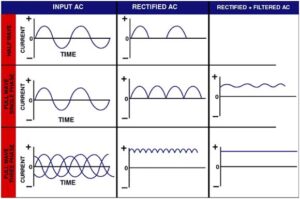Types of Currents for Magnetic Particle Inspection
AC (Alternating Current)
Alternating current oscillates in direction at a frequency of 50 or 60 cycles per second. In India, a frequency of 50 cycles is standard. As AC is commonly available, it is a convenient choice for magnetic particle inspection. However, when AC is used to induce a magnetic field in ferromagnetic materials, the resulting field is confined primarily to the surface due to the “skin effect.” This occurs because the rapid changes in current direction don’t allow deeper domains time to align. Thus, AC is recommended mainly for surface defect detection, particularly for identifying cracks induced by heat treatment. AC also provides effective particle movement.
FWDC (Full Wave Direct Current)
Full wave rectification reverses negative current to positive instead of eliminating it, yielding a pulsating DC with no gaps between pulses. Filtering is used to smooth the abrupt polarity shifts in rectified current. While particle mobility isn’t as high as in half-wave AC due to reduced pulsation, the depth of subsurface magnetic field improves.
HWDC (Half Wave Direct Current)
Passing single-phase AC through a rectifier permits current flow in one direction. Half of each cycle is blocked, producing a pulsating, one-directional current that rises to a peak and returns to zero. No current flows during the blocked reverse cycle. HWDC exhibits half the amperage of unrectified AC and is sometimes referred to as pulsating DC. Its pulsation enhances magnetic particle indications by agitating particles and augmenting their mobility, significantly enhancing inspection sensitivity.
HWDC combines advantages of both AC and FWDC. It penetrates the part like FWDC and offers particle mobility akin to AC. Modern systems predominantly use this current type.

